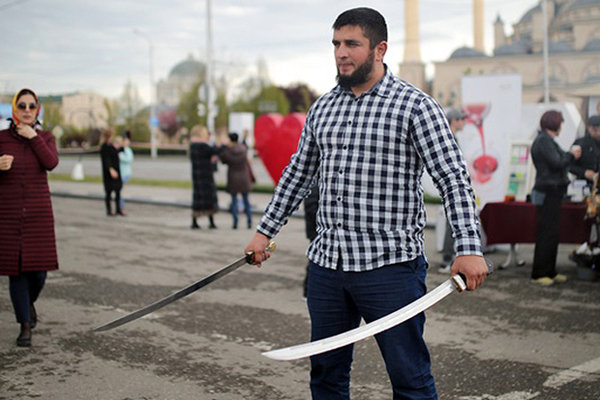Valenki wear out most quickly from the bottom and very often are soled with leather or other durable material to prevent this, so they are often worn with galoshes. Also, to protect from getting wet – they use a rubber sole, and there are valenki with glue-sew and molded soles.
Russian soldier on skis wearing valenki boots Valenki stem from the traditional felt boots worn by nomads of the Great Steppe (including Southern ), whose history goes back over 1500 years. However, as it’s supposed, the boots appeared at the beginning of the 18th century. Valenki became widespread only in the first half of the 19th century, when they started being manufactured by industrial methods. Before this, they were quite expensive and only wealthy people could afford to have them. The increasing complexity of needs, the growing influence of the urban mores to the village caused the change of bast shoes with felt boots, and with it, the broad development of fulling production. Valenki became less popular in the urban life in recent decades because winters in turned to be more soft and slushy, and as result – lighter and waterproof footwear gradually won popularity and replaced valenki.
Valenki are associated with a traditional rustic style of clothing; in cities they are usually worn by little kids, or they are worn by one and all in a severe, when other shoes don’t protect from the cold. Descargar super smash bros brawl wii iso supercomprimido. Before the, the production of valenki was concentrated in the Semenov district of province, in the District of, and in the in. In 1900, contemporary jackboot factories of Russia produced 1.4 million pairs of valenki in the amount of 2.1 million. In 1900, a pair of valenki cost 1.5 rubles, in 1912 - 2 rubles, at the end of 1916 the speculative price reached up to 12-18 rubles per pair. See also [ ] • • • References [ ].

Imperij vrača udarce An American actor who’s appeared in movies starring Leonardo Di Caprio and Tom Cruise has landed an unwitting role in a real-life thriller about the grinding struggle against graft in Europe’s most corrupt country. Michael-John Wolfe, who makes personalized newscasts for birthdays and other events as a side gig, said he had no idea that a video he was paid to shoot suggesting Ukraine’s leading anti-corruption campaigner embezzled U.S. Funds would be posted on YouTube and cited by opponents in Kiev as the real deal. “I thought it was a prank,” Wolfe said by email, adding that he only knows the screen name of the person who hired him on Fiverr, an online marketplace where he charges $50 to orate 150 words. “I’ve been doing these newscasts since 2011 and never had a problem before. I apologize if anyone was hurt.” With just 16,000 views, Wolfe’s video is the least of Vitaliy Shabunin’s worries.
The founder of the U.S.-funded Anti-Corruption Action Center, whose work is critical to unlocking billions of dollars of aid for Ukraine’s cash-strapped government, has become a lightening rod for entrenched interests in a nation where runaway corruption sparked two revolutions in the space of a decade. Shabunin, 32, has been under relentless pressure since March, months after an initiative he championed -- mandatory asset disclosures by officials -- came into force, angering everyone from prosecutors and politicians to tax authorities and even the security services. The revelations of million-dollar bank accounts, mansions and luxury goods sparked outcry from a public that already considered rampant graft more menacing than Russia. Shabunin, a former councilman from the western city of Rivne who’s at turns jovial and resolute, spoke in an interview in Kiev after another video surfaced that’s far more damaging than Wolfe’s fake newscast. It shows him finally losing his temper and punching a self-proclaimed independent journalist who’d been stalking him with a camera and trolling him online for months. The June clip of the activist dropping the agitator, Vsevolod Filimonov, with a quick right cross while wearing a backpack and clutching a sports jacket has been viewed 90,000 times.
It’s now evidence in an assault probe that carries a maximum penalty of three years in prison. “I hit a person who was haunting my team,” Shabunin told reporters after his Aug.
“I am prepared to bear responsibility for that.”. Before the uprising, Filimonov was fired from an election-monitoring watchdog in his native Luhansk, one of two regions now partly held by rebels, after he was recorded soliciting a $3,000 bribe from a local official. Filimonov is an aide to Serhiy Melnychuk, a lawmaker who was stripped of his immunity for alleged ties to organized crime, which he denies. Semenchenko says the pair do the bidding of the military’s top prosecutor, Anatoliy Matios, who was reprimanded for exceeding his authority by trying to draft Shabunin into the army. Ipos 4 program toko. Matios, who was also unreachable by phone and via Facebook, slammed Shabunin on the social network in July, calling him a “journalist-beating conscription-dodger.” Shabunin was on his way to a military recruitment center when the altercation with Filimonov occurred. He was there to contest a draft order Matios’s office issued challenging a medical deferment that exempts him from army service.